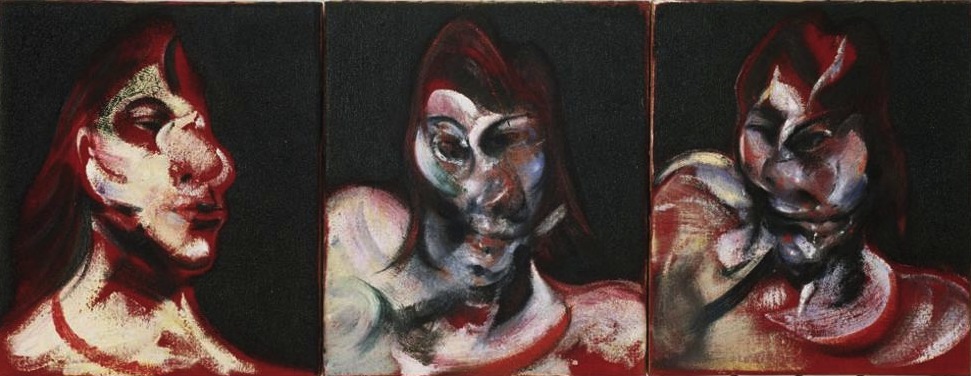Undertaking a profane career that encompassed amphetamine-psychotic cat burglary in the ’60s for which she served prison time, Henrietta Moraes was the epitome of willful caprice and bohemianism throughout her adventurous life. Initially emerging in Soho pubs such as the famous Colony Room and Gargoyle Club as a distinctive and magnetic socialite, she met such era-defining characters as Lucian Freud and Francis Bacon and with them spent long sozzled days and nights. Freud, who became her lover, painted her several times while Bacon portrayed her about twenty times.
The latter part of Moraes life, free of intoxication and hampered by poverty, included a stay at Roundwood House in County Laois as a caretaker during the ’70s and ’80s, where she entertained such guests as Eric Burdon of The Animals, before her return to London.

The three aspects of Moraes presented by Francis Bacon in his 1963 Three Studies for a Portrait of Henrietta Moraes convey the mercurial and changeable impetuosity of his subject in a happy confluence of personality and aesthetic – especially in Bacon’s characteristic virtuosic application of paint, a kind of rehearsed and perfected spontaneity.
As opposed to the more recently famous and lucrative Portrait of Henrietta Moraes, which sold for 21.3 million pounds in 2012 and which could be seen as a charged study of fleshliness, the form and the deformation of the body; these three panels exhibit a brooding consideration of psychological states and presences that do not shirk the materiality of flesh and bone. All three panels show Moraes stripped of all extraneous ornament, of her skin even; paring back any obscuring pretensions of social place.
Thus Bacon, true to form, shows a psychology infused with the informative and illustrative instrument of flesh, both necessarily as a figurative painter and whimsically as a flaying discoverer. His flesh is not just so here but is an interlocutor in a symbiotic dialogue with psyche.
The carnal palette of the left panel’s Moraes could mark the outset of a progression within the three aspects that is paradoxical in light of the sketchy character of the paint on the subject’s neck and face. This paradox is illuminating: we encounter Moraes in the flesh, that is as we would socially – a person wrapped in a body. Yet the sketchiness of the depiction also undermines this visual verisimilitude, re-creates it as inadequate and insufficient for understanding – both of a picture and of a person. The left panel both states fleshliness and criticises it, as the rough-hewn white or pallor could be seen, as well as a reference to skin, as the residual blank resulting from the erasure of fleshliness.
The mood of the left panel is incipience, acquaintance. Moraes is tight-lipped and averts her gaze, as if the viewer deforms or dehumanises her with their own. This is the primeval moment of every acquaintance – the recognition of bodily presence, the presumption of the body’s encapsulation of a person and the imprecise imbrication of both as a part of the perception of another.
The above-mentioned progression through the panels could be sequential but certainly is not narratival: nothing happens to Moraes but Moraes happens to us. Bacon grants agency to her as well as himself as painter and memorialising friend.
The middle panel sees Moraes see us. Her gaze is piercing and paralyses ours. Her shoulder roils up in a disfigurement of body or perhaps a dematerialisation of it. The central axis of her face is shown in subcutaneous blacks and grays, perhaps the hues of intellect. Here is a personal exclusive engagement beyond initial acquaintance. If not friendship, the second panel evokes a mutual knowledge – we see, as Bacon did, that animate spirit that lies within flesh while Moraes sees us percipiently , a career in socialising rendering her adept in the apprehension of people. As Moraes’ late portraitist Maggi Hambling said of her eyes: “They were so deep. They looked straight through me to my soul, exposing her own at the same time.” There is a fierce, unflinching intimacy in this second panel.
The third panel sees an increased dissolution of the physical features either by way of a rotary movement of the head or the rotary swirls of Bacon’s brush. Rather than the infliction of violence on the subject, Bacon’s idiosyncratic re-forming technique covers the canvas and seeks to uncover Moraes, divesting her of a reductive fleshly mimesis and invest her with a complex interaction of body and psychology. The violence we see is that of the urgency of an authentic characterisation of both Moraes’ person and of the relationship between her and the artist.


